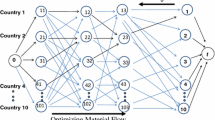Abstract
This paper presents a systematic mathematical programming approach for active demand management in process industries. The proposed methodology aims to determine optimal pricing policies as well as output levels for substitute products, while taking into consideration manufacturing costs, resource availability, customer demand elasticity, outsourcing and market competition. First, profit maximisation analytical formulae are derived for determining Nash equilibrium in prices for a duopolistic market environment where each company produces only one product. An iterative algorithm is then proposed so as to determine the decision-making process by solving a series of non-linear mathematical programming (NLP) models before determining the Nash equilibrium in prices for the competing companies. The proposed algorithm is extended in order to accommodate the case of multi-product companies, each one selling a set of substitute products at different prices. The applicability of the proposed methodology is demonstrated by a number of illustrative examples.
Similar content being viewed by others
References
Acutt MZ, Dodgson JS (1996) Cross-elasticities of demand for travel. Transp Policy 4:271–277
Alves DCO, Bueno RD (2003) Short-run, long-run and cross-elasticities of gasoline demand in Brasil. Ener Econ 25:191–199
Bertrand J (1883) Theorie mathematique de la richesse sociale. J Savants 499–508
Besanko D, Gupta S, Jain D (1998) Logit demand estimation under competitive pricing behaviour: An equilibrium framework. Manage Sci 44:1533–1547
Birge JR, Drogosz J, Duenyas I (1998) Setting single-period optimal capacity levels and prices for substitutable products. Int J Flexible Manuf Syst 10:407–430
Brooke A, Kendrick D, Meeraus A, Raman R (1998) GAMS: a user’s guide. GAMS Development Corporation, Washington
Choi SC, Desarbo WS, Harker PT (1990) Product positioning under price competition. Manage Sci 36: 175–199
Cournot A (1838) Recherches sur les principes mathematiques de la theorie des richesses. Hachette, Paris
Coy P (2000) The power of smart pricing. Economics April 10th, Business Week
Drud AS (1985) CONOPT: a GRG code for large sparse dynamic nonlinear optimization problems. Math Progr 31: 153–191
Eliashberg J, Steinberg R (1987) Marketing-production decisions in an industrial channel of distribution. Manage Sci 33: 981–1000
Hotelling H (1929) Stability in Competition. Econ J 39: 41–57
Kaihara T (2001), Supply chain management with market economics. Int J Product Econ 73: 5–14
Kaihara T (2003), Multi-agent based supply chain modelling with dynamic environment. Int J Product Econ 85: 263–269
Kotler P, Armstrong G, Saunders J, Wong V (1996) Principles of marketing. Prentice-Hall, Englewood Cliffs
Kreps D, Scheinkman J (1983) Quantity pre-commitment and Bertrand competition yield Cournot outcomes. Bell J Econ 14: 326–337
Lanning S, Mitra D, Wang Q, Wright M (2000) Optimal planning for optical transport networks. Philos Trans Roy Soc Lond Ser A–Math Phys and Engi Sci 358: 2183–2196
Manugistics Inc., http://www.manugistics.com/
Makridakis S, Wheelwright SC (1982) The handbook of forecasting: a manager’s guide. Wiley, Newyork
Min H, Zhou G (2002) Supply chain modeling: past, present and future. Comput Indus Eng 43: 231–249
Nagle T, Holden R (1995) The strategy and tactics of pricing: A guide to profitable decision making, 2nd edn. Prentice-Hall, Englewood Cliffs
Nash JF (1951) Non-cooperative games. Ann Math 54: 286–295
Parlar M, Weng ZK (2006) Coordinating pricing and production decisions in the presence of price competition. Euro J Operl Res 170: 211–227
Pashigian BP (1998) Price theory and applications, 2nd edn. McGraw-Hill, Boston
Pindyck RS, Rubinfield DL (1992) Microeconomics, 4th edn. Prentice-Hall, Upper Saddle River
Rapt Inc., http://www.rapt.com/
Shankar V, Krishnamurthi L (1996) Relative price sensitivity to retailer promotional variables and pricing policy: an empirical analysis. J Retail 72: 249–272
Shapiro, AC (1989) Theories of oligopoly behavior. In: Schmalensee R, Willig RD (eds.)Handbook of industrial organization 329–414
Sherali HD, Soyster AL, Murphy FH (1983) Stackelberg-Nash-Cournot equilibria:characterizations and computations. Oper Res 31: 253–276
Sherali HD, Leleno JM (1988) A mathematical programming approach to a Nash-Cournot equilibrium analysis for a two-stage network of oligopolies. Oper Res 36: 682–702
Smithies A (1941) Optimum Location in Spatial Competition. J Polit Econ 49: 423–439
Stackelberg VH (1934) Marktform und Gleichgewicht. Springer, Vienna
Stavins J (1997) Estimating demand elasticities in a differentiated product industry: the personal computer market. J Econ Busin 49: 347–367
Straffin PD (1993) Game theory and strategy. The Mathematical Association of America, Washington
Tellis GJ (1988) The price elasticity of selective demand: a meta-analysis of econometric models of sales. J Market Res 25: 331–341
Varian HR (1992) Microeconomic analysis, 3rd edn. W.W. Norton, New York
Vives X (1999) Oligopoly pricing. The MIT Press, Cambridge
Zhao W, Wang Y (2002) Coordination of joint pricing-production decisions in a supply chain. IIE Trans 34: 701–715
Author information
Authors and Affiliations
Corresponding author
Rights and permissions
About this article
Cite this article
Levis, A.A., Papageorgiou, L.G. Active demand management for substitute products through price optimisation. OR Spectrum 29, 551–577 (2007). https://doi.org/10.1007/s00291-006-0064-1
Published:
Issue Date:
DOI: https://doi.org/10.1007/s00291-006-0064-1




